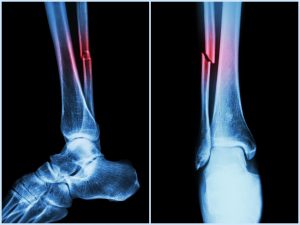How To Make Ankle Injury Claims
By Danielle Jordan. Last Updated 7th June 2024. Ankle accidents can be devastating at times. Not only are they painful, but they can limit your mobility, lower your productivity, and have a massive impact on your quality of life. If the injury has occurred as the result of an accident, then it may be possible to get compensation. Below, we take a look at ankle injury claims in detail.
Ankle injuries are not uncommon. Whether you’re playing sports or working in an office, a simple trip or fall can be all it takes to twist, sprain, or even fracture the bones of the ankle. This often results in bruising, dislocations, fractures, and lacerations, as well as an ankle sprain or strain.
Ankle injuries that follow an accident should not be taken lightly. Such injuries are capable of causing a huge upheaval in your lifestyle and, for this reason, it is always important to consider ankle injury compensation claims. Making ankle Injury claims can help you get compensation for the present and future financial loss that would arise as a result of the accident.
To get in touch with our team of advisors:
- Call on 0800 073 8804
- Start your claim online
- Use the live chat feature
Select a Section:
- What Is The Average Payout For An Ankle Injury?
- Top Tips On Proving Ankle Injury Claims
- Different Types Of Ankle Injury Claims
- How No Win No Fee Personal Injury Solicitors Could Help You
- Learn More About Ankle Injury Claims
What Is The Average Payout For An Ankle Injury?
There is no average payout for an ankle injury in the UK because every case is unique and compensation is based on numerous factors, including the severity of harm, loss of amenity, and the impact on your quality of life.
If you have a successful ankle injury claim, your compensation could be formed of up to two parts, known as heads of loss:
- General damages, which account for physical pain and emotional distress caused by your injuries.
- Special damages, or compensation covering financial losses or expenses directly resulting from your ankle injury.
Keep hold of any documents that will allow you to include special damages in your claim. For example, a broken ankle compensation payout could include a payment covering medical bills or missed work earnings if you can provide receipts, invoices or payslips.
Those calculating the general damages side of a payout might use medical evidence for guidance. They could also look at the Judicial College Guidelines (JCG), a document that features guideline compensation brackets for various injuries.
The table you can see below features JCG figures, except for the top line. Because ankle injury compensation is based on each case’s individual merits, the table is only a guide.
| Injury | Severity | Amount |
|---|---|---|
| Multiple injuries and expenses | Up to £200,000+ | |
| Ankle | Very Severe | £61,090 to £85,070 |
| Severe | £38,210 to £61,090 |
|
| Moderate | £16,770 to £32,450 | |
| Modest | Up to £16,770 | |
| Achilles Tendon | Most Serious | In the region of £46,900 |
| Serious | £30,500 to £36,720 |
|
| Moderate | £15,370 to £25,710 |
|
| Minor | £8,870 to £15,370 |
|
| Foot | Moderate | £16,770 to £30,500 |
You can talk in more detail about personal injury compensation by calling our advisors today. They can also answer any questions you may still have regarding the average payout for an ankle injury.
Top Tips on Proving Ankle Injury Claims
Unfortunately, we cannot provide the average compensation for an ankle injury, as settlements can vary a great deal from person to person. However, one thing that is consistent across all claims is the requirement to be able to prove your injuries were caused by negligence. The most effective way to achieve this is to gather as much evidence as you can.
In the list below, you’ll find a few helpful examples of evidence that you could acquire.
- Medical records – Once you have received treatment from a medical professional, the details regarding your injury will be logged in an official capacity. Ankle injury compensation amounts are often influenced by the severity of any injuries and the negative impact on your life; a medical report can illustrate these factors.
- Visual evidence – CCTV footage and photographs can be a good way of establishing negligence if they show how the accident causing your injury happened.
- Witness contact details – If you have a way of contacting those who saw what happened, a statement can be taken from them at a later date. A solicitor can assist with this step.
This list is not exhaustive, however. There are other ways of proving that your injuries were caused by negligence. For more information on the steps you can take to seek ankle injury settlement amounts, get in touch with us today.
Different Types Of Ankle Injury Claims
There are lots of different daily situations that could result in suffering an injury to your ankle. In some of these situations, you will be owed a duty of care, which is vital when seeking ankle injury settlement amounts in the UK. These situations include:
- While in public places. The individual or organisation of that space owes you a duty of care under the Occupiers’ Liability Act 1957. This means that you should be reasonably safe while using the premises for the permitted purposes.
- While at work. The Health and Safety at Work etc. Act 1974 (HASAWA) sets the duty of care while you are carrying out work-related activities. This means that as far as reasonably practicable, your employer must ensure the health, safety and welfare at work of their employees.
- While on the roads. All road users must navigate in a way that prevents damage and harm to themselves and to others. This is their duty of care. As part of this duty, they should adhere to the Highway Code and the Road Traffic Act 1988.
To be able to make a personal injury claim, you must meet the eligibility criteria. This means that all ankle injury claims must be supported with evidence that proves:
- You were owed a duty of care.
- There was a breach in this duty.
- You suffered an ankle injury because of this breach.
If you have any questions about the average payout for an ankle injury or the eligibility criteria to make a personal injury claim, please contact one of our advisors.
How No Win No Fee Personal Injury Solicitors Could Help You
If a personal injury solicitor decides to take on your ankle injury claim, they could offer to work under a ‘No Win No Fee’ arrangement. A popular type of No Win No Fee agreement that is used is called a Conditional Fee Agreement CFA. So when making ankle injury claims with a No Win No Fee solicitor, you could benefit from:
- Not having to pay any solicitor fees upfront,
- Not having to pay solicitor fees as the case moves forward
- If the case should fail, not paying for the service the solicitor has provided.
When personal injury claims represented by a No Win No Fee solicitor succeed, a success fee can be taken by the solicitor. Under the Conditional Fee Agreements Order 2013, the success fee is legally capped at a maximum of 25%, so the claimant always receives the majority.
Contact Our Team Today
We are here to offer help, expertise, and assistance. Our legal consultation session is free and, if we find out that your case of compensation claim is valid, we can help you settle that claim as quickly as possible.
- Call on 0800 073 8804
- Start your claim online
- Use the live chat feature
Learn More About Ankle Injury Claims
- NHS – Treating sprains and strains
- NHS – Broken ankle information: Read this NHS guide to learn how to treat an ankle injury.
- Slip Trip or Fall Compensation Claims: Find out if you can claim for an ankle injury after a slip trip or fall accident.
- Whiplash Compensation Claims: Discover more about whiplash claims here.
- How Much Compensation Can I Claim For A Sprained Ankle?
Do you have further questions about how to receive ankle injury compensation? If so, please contact our team for free legal advice. They can answer any queries you have about making an ankle injury claim and can even provide you with a compensation estimate.
Other Useful Guides
- Hereford Personal Injury Solicitors
- Hillingdon Personal Injury Solicitors
- Hoddesdon Personal Injury Solicitors
- Hounslow Personal Injury Solicitors
- Huddersfield Personal Injury Solicitors
- Inverness Personal Injury Solicitors
- Ipswich Personal Injury Solicitors
- Isle of Wight Personal Injury Solicitors
- Islington Personal Injury Solicitors
- Jarrow Personal Injury Solicitors
- Arm Injury Claims
- I Tripped Over A Bottle Or Glass And I Was Injured
- Accidents On Private Property
- Compensation For a Broken Metatarsal
- Learn how to sue a company for a personal injury through this helpful guide
- Find out how non-fault accident claims work with this article
- You could be owed car park accident compensation. Learn more in this guide.



